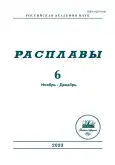TWO TYPES OF GALLIUM EXPOSURE TO ALUMINUM
- Авторлар: Skachkov V.M.1, Pasechnik L.A.1, Bibanaeva S.A.1, Medyankina I.S.1, Sabirzyanov N.A.1
-
Мекемелер:
- Institute of Solid State Chemistry of the Ural Branch of the RAS
- Шығарылым: № 6 (2023)
- Беттер: 624-633
- Бөлім: Articles
- URL: https://journals.rcsi.science/0235-0106/article/view/162336
- DOI: https://doi.org/10.31857/S0235010623060075
- EDN: https://elibrary.ru/DIQQGN
- ID: 162336
Дәйексөз келтіру
Толық мәтін
Аннотация
The effect of gallium on aluminum during their fusion is investigated. The corrosion rate of aluminum alloys with 1, 2 and 5 at % gallium content was experimentally determined, which was 0.001, 0.00101 and 0.00062 g/m2 · h, respectively, which is less than that of pure grade A99 aluminum – 0.0016 g/m2 · h. The rate of dissolution of these alloys in acidic and alkaline media is determined. X-ray phase analysis showed the homogeneity of the alloys under consideration. The morphology of aluminum alloys with gallium was studied, after exposure to an aggressive environment – a solution of hydrochloric acid. The possibility of obtaining hydrogen and nanoscale alumina by decomposition of water by activated gallium aluminum alloy is shown. Activation of the aluminum surface by gallium alloy occurs according to the Rebinder effect and the article presents a micrograph of the surface of aluminum treated with Ga-Sn alloy, clearly demonstrating this effect. When using metallic gallium in contact with aluminum, the interaction requires heating to a temperature above 30°C (the melting point of gallium is 29.7°C), the melting point of the eutectic composition 92Ga–8Sn is 20.0°C, which allows the interaction to begin at room temperature. At temperatures of about 4°C, activated aluminum can be stored for a long time. The quality of hydrogen obtained by decomposition of water should be higher than that obtained by cracking, and the cost is close to a well-developed technology of electrolysis of water and no more than 2 times the cost of its synthesis via cracking of hydrocarbons. Gallium and its liquid alloys are non-toxic, almost do not interact with water, activate aluminum, preventing the formation of a protective oxide film, penetrate into the intergranular space and aluminum easily interacts with water, forming hydrogen and aluminum hydroxide.
Авторлар туралы
V. Skachkov
Institute of Solid State Chemistry of the Ural Branch of the RAS
Хат алмасуға жауапты Автор.
Email: skachkov@iyim.uran.ru
Russia, Yekaterinburg
L. Pasechnik
Institute of Solid State Chemistry of the Ural Branch of the RAS
Email: skachkov@iyim.uran.ru
Russia, Yekaterinburg
S. Bibanaeva
Institute of Solid State Chemistry of the Ural Branch of the RAS
Email: skachkov@iyim.uran.ru
Russia, Yekaterinburg
I. Medyankina
Institute of Solid State Chemistry of the Ural Branch of the RAS
Email: skachkov@iyim.uran.ru
Russia, Yekaterinburg
N. Sabirzyanov
Institute of Solid State Chemistry of the Ural Branch of the RAS
Email: skachkov@iyim.uran.ru
Russia, Yekaterinburg
Әдебиет тізімі
- Meroueh L., Eagar T.W., Hart D.P. // ACS Applied Energy Materials. 2020. 3. № 2. P. 1860–1868. https://doi.org/10.1021/ACSAEM.9B02300
- Meroueh L., Neil L., Eagar T.W., Hart D.P. // ACS Applied Energy Materials. 2021. 4. № 1. P. 275–285. https://doi.org/10.1021/acsaem.0c02175
- Virendrakumar G. Deonikar, Hern Kim. // Applied Surface Science. 2022. 578. P. 152054. https://doi.org/10.1016/j.apsusc.2021.152054
- Gabriella Amberchan, Isai Lopez, Beatriz Ehlke et al. // ACS Applied Nano Materials. 2022. 5. № 2. P. 2636–2643. https://doi.org/10.1021/acsanm.1c04331
- Sheng P., Zhang S., Yang J., Guan C., Li J., Liu M., Pan W., Wang Y. // International Journal of Energy Research. 2021. 45. № 6. P. 9627–9637. https://doi.org/10.1002/er.6486
- Yatsenko S.P., Skryabneva L.M., Shevchenko V.G. Sposob polucheniya vodoroda i khimicheskiy reaktor dlya yego osushchestvleniya [A method for producing hydrogen and a chemical reactor for its implementation] Pat. 2397141 RF. IPC C01B 3/08, B01J 7/00. Published 20.08.2010, Bull. № 23. [In Russian].
- Yatsenko S.P., Skachkov V.M., Shevchenko V.G. Polucheniye vodoroda razlozheniyem vody aktivirovannym alyuminiyem [Obtaining hydrogen by decomposition of water with activated aluminum] // Zh. prikladnoy khimii. 2011. 84. № 1. P. 35–38. [In Russian].
- Stojic D.L., Marceta M.P., Sovilj S.P., Miljanic S.V.S. // J. Power Sources. 2003. 118. № 12. Р. 315–319. https://doi.org/10.1016/S0378-7753(03)00077-6
- Powder Diffraction File JCPDS-ICDD PDF-2 (Set 1-47). (Release, 2016). Available at: www.url: https://www.icdd.com/pdf-2/ (дата обращения 25.05.2021).
- Filatov A.A., Suzdaltsev A.V., Molchanova N.G., Pankratov A.A., Zaikov Yu.P., Ostanina T.N. Korrozionnoye povedeniye splavov i ligatur Al–Zr v rastvore NaCl [Corrosion behavior of Al–Zr alloys and ligatures in NaCl solution] // Butlerovskiye soobshcheniya. 2018. 55. № 8. P. 109–115. [In Russian].
- Issledovaniye vliyaniya primesey, soputstvuyushchikh alyuminiyu pri yego poluchenii, na tekhnologicheskiye svoystva slitkov iz alyuminiya, deformiruyemykh splavov i reglamentatsiya soderzhaniya galliya, litiya, kal’tsiya i skandiya v alyuminiyevykh splavakh [Study of the influence of impurities accompanying aluminum during its production, on the technological properties of aluminum ingots, wrought alloys and regulation of the content of gallium, lithium, calcium and scandium in aluminum alloys]. R&D. Work code: 1139-020. VNTITs. 1987. Inv. № 59955 (reg. № 0285. 0 079282). [In Russian].
- Malkin A.I. Zakonomernosti i mekhanizmy effekta Rebindera [Patterns and mechanisms of the Rebinder effect] // Kolloidnyy Zhurnal. 2012. 74. № 2. P. 239–256. [In Russian].
- Yatsenko S.P., Pasechnik L.A., Skachkov V.M., Rubinshtein G.M. Tekhnologii polucheniya i primeneniye zhidkikh splavov [Gallium: Technologies for the production and application of liquid alloys]: Monograph. M.: RAN, 2020. [In Russian].
Қосымша файлдар
















